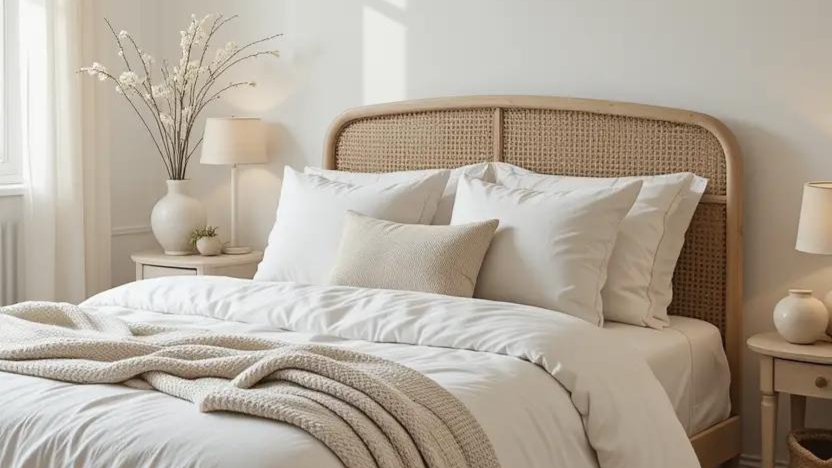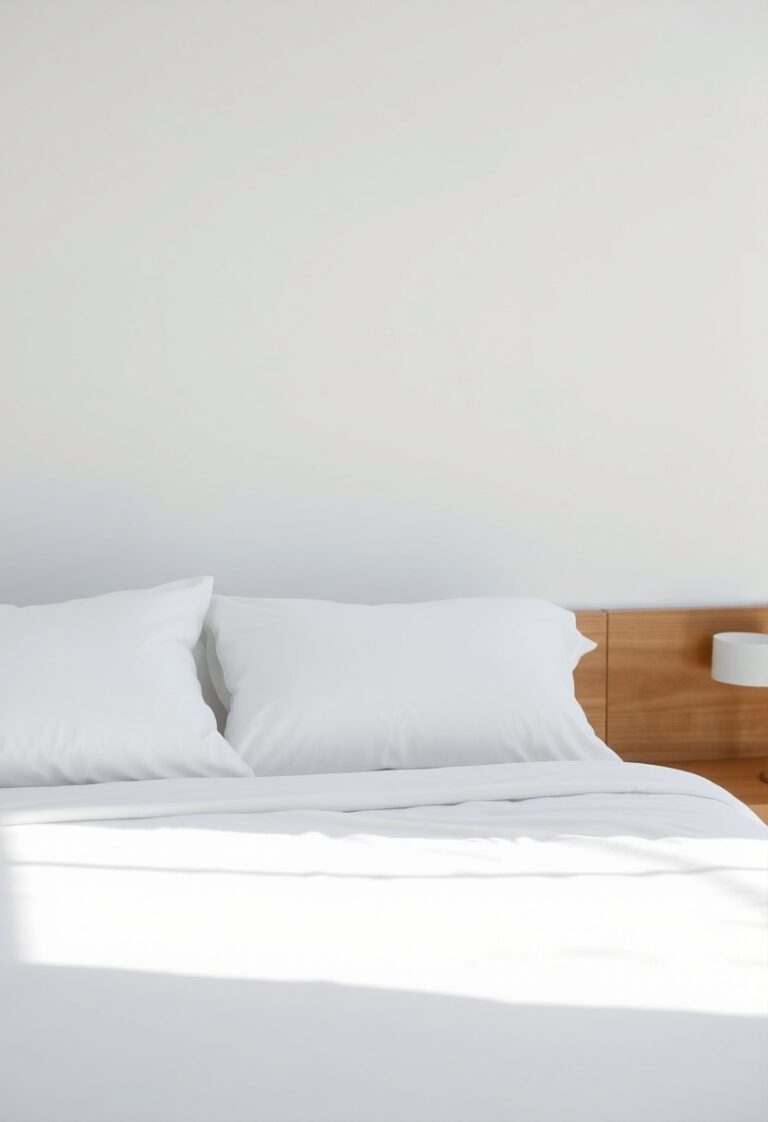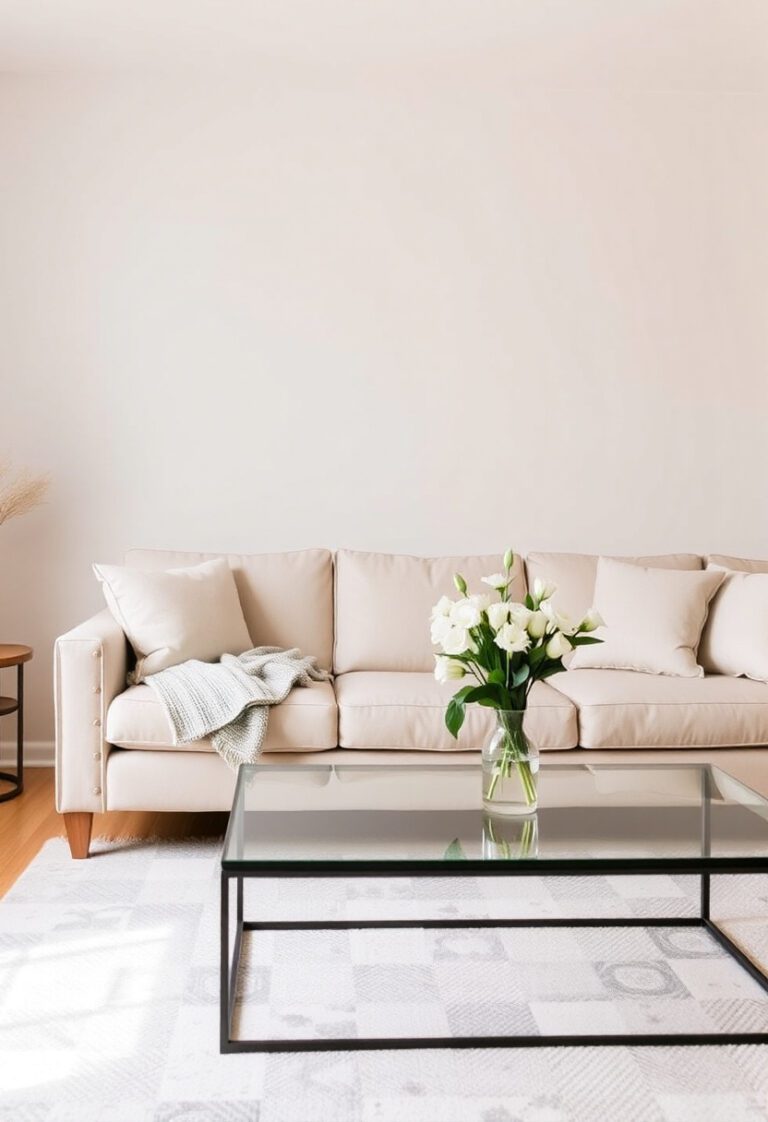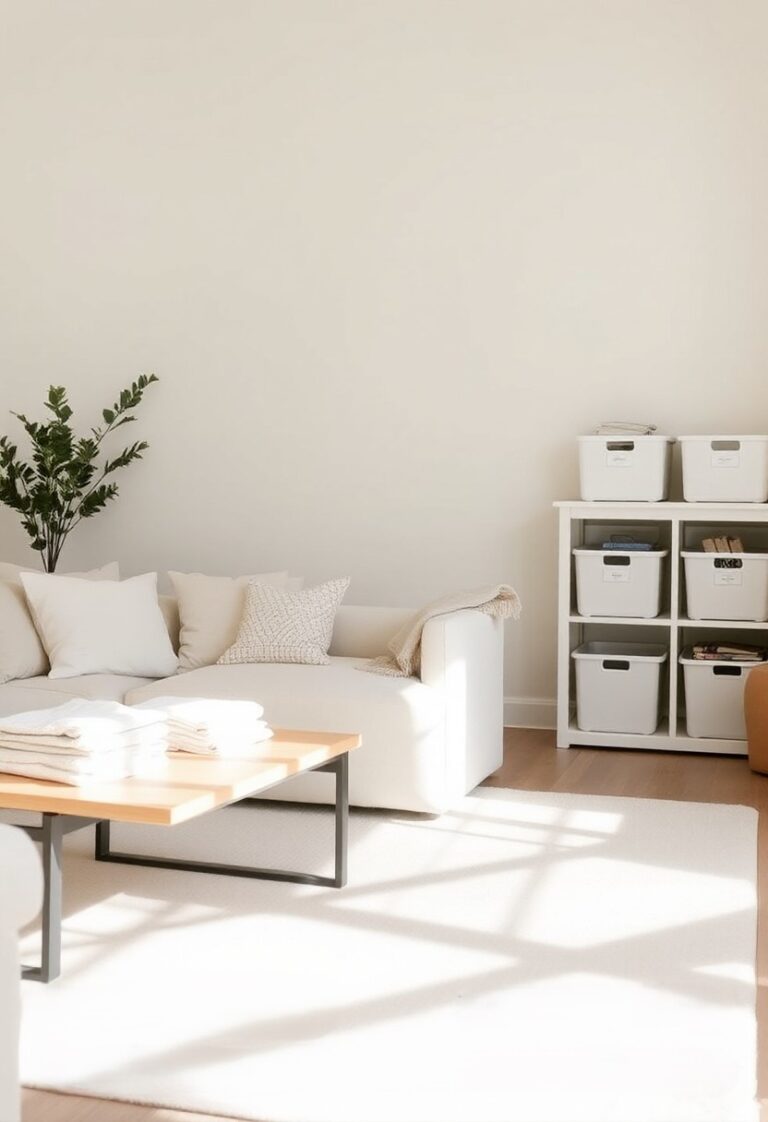Creating a neutral bedroom offers an excellent foundation for relaxation and restful sleep. A well-designed neutral bedroom combines subtle color palettes with varying textures to create depth and interest without overwhelming the senses. From soft beiges and creams to gentle grays and taupes, neutral bedrooms provide a versatile backdrop that can evolve with your changing tastes while maintaining a serene atmosphere.
Whether you’re redesigning your entire bedroom or looking for simple updates to refresh your space, these neutral bedroom ideas will help you create a tranquil retreat that feels both stylish and calming. The beauty of a neutral bedroom lies in its adaptability – it can be easily updated with seasonal accessories while maintaining its core peaceful essence.
Let’s explore fifteen inspiring ways to create a neutral bedroom that’s both sophisticated and deeply relaxing.
1. Layer Different Neutral Tones
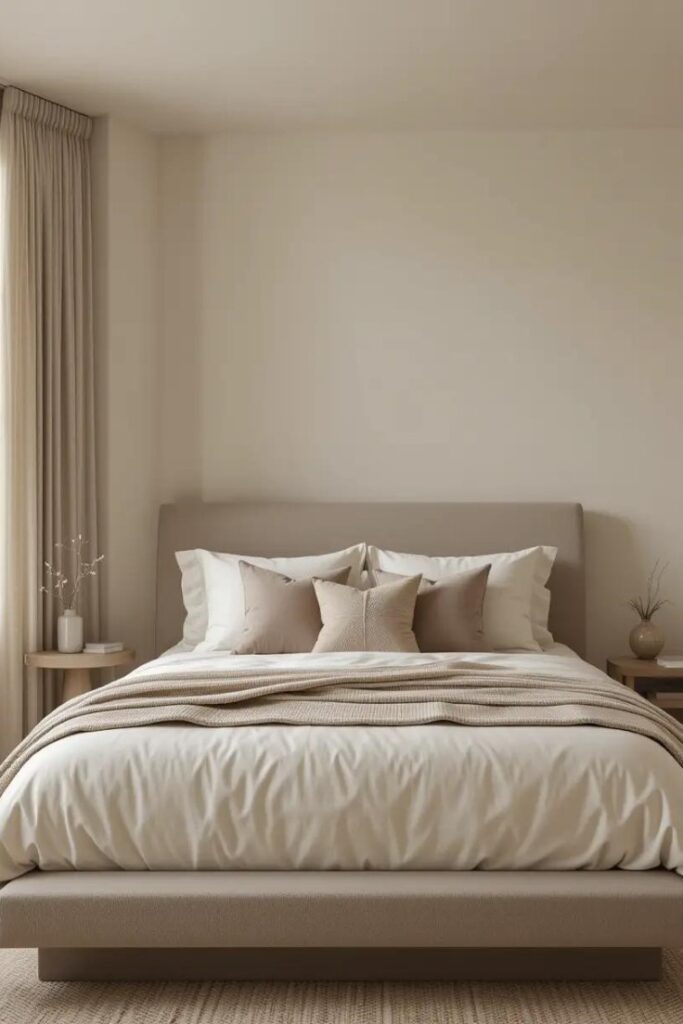
One of the most effective approaches to a neutral bedroom is layering various shades within the same color family. Rather than sticking to a single neutral tone, incorporate several related hues to create depth and visual interest. For example, pair warm beige walls with cream bedding, oatmeal curtains, and taupe accent pillows.
This subtle variation prevents a neutral bedroom from appearing flat or one-dimensional. The key is choosing neutrals with similar undertones—either all warm or all cool—to maintain harmony throughout the space.
2. Focus on Texture in Your Neutral Bedroom
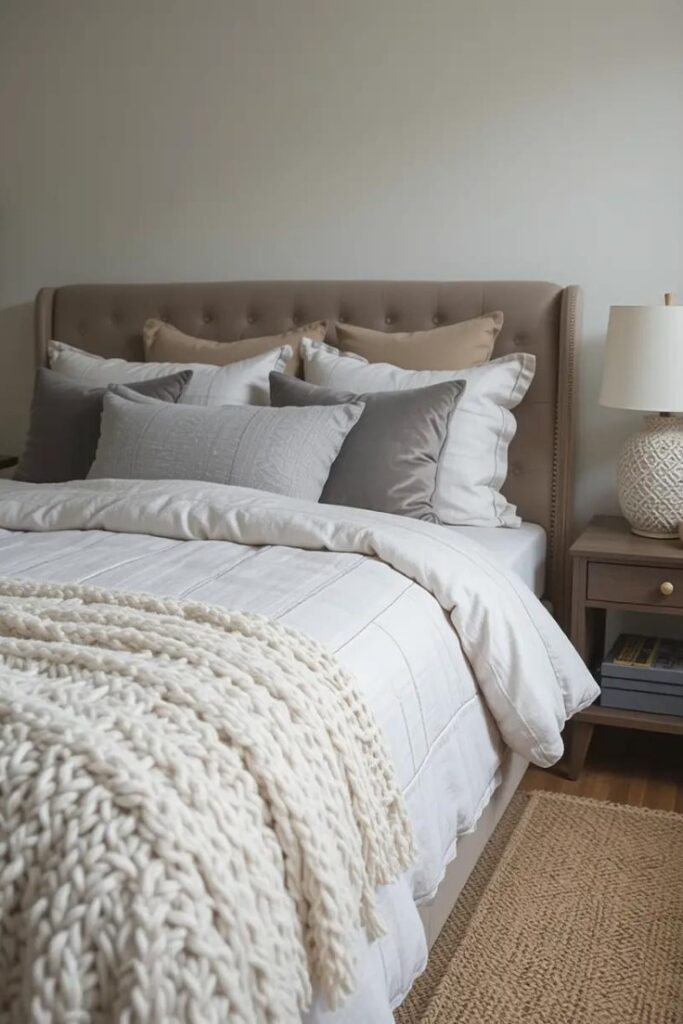
In neutral bedrooms where color contrast is minimal, texture becomes especially important. Incorporate various textures through bedding, furnishings, and décor to add dimension and tactile appeal to your neutral bedroom.
Consider including:
- Chunky knit throws
- Linen or cotton duvet covers
- Velvet accent pillows
- Natural fiber rugs
- Woven wall hangings
- Textured ceramic lamps
The contrast between smooth and rough, soft and coarse creates visual interest that compensates for the limited color palette in a neutral bedroom.
3. Incorporate Natural Materials
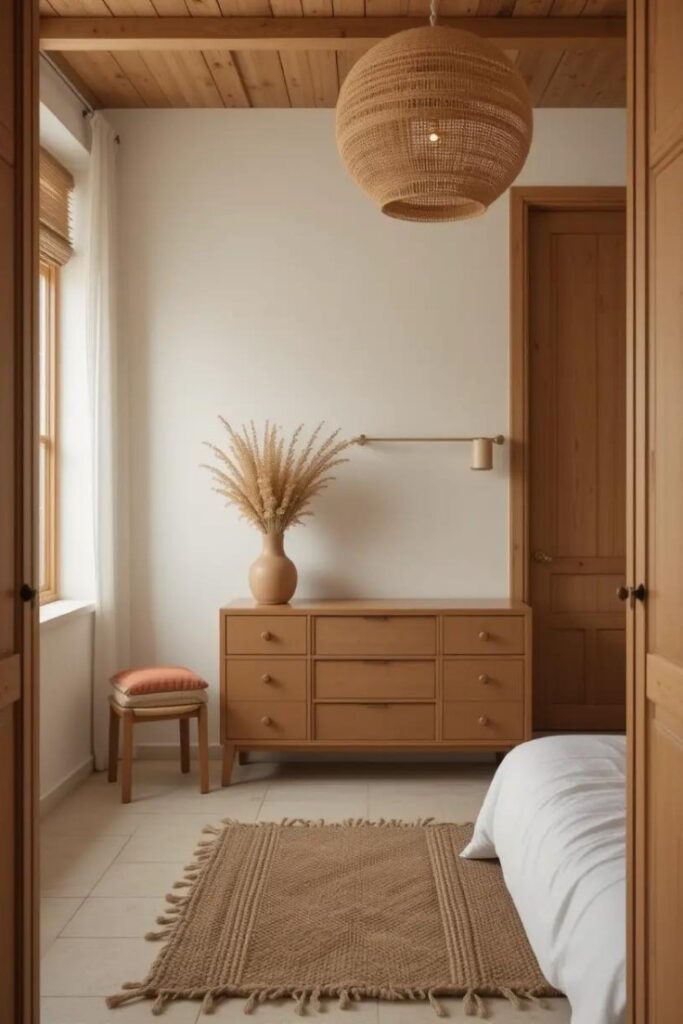
Natural materials enhance the organic, grounding quality of a neutral bedroom. Wood, rattan, jute, clay, and stone elements bring warmth and character while maintaining the room’s peaceful neutral palette.
Try introducing:
- Wooden bedside tables or dressers
- Rattan headboards or light fixtures
- Clay vases or decorative objects
- Stone table lamps
- Jute or sisal area rugs
These materials add authentic texture and subtle color variation that enriches your neutral bedroom design while keeping it connected to nature.
4. Create a Neutral Bedroom with Architectural Details
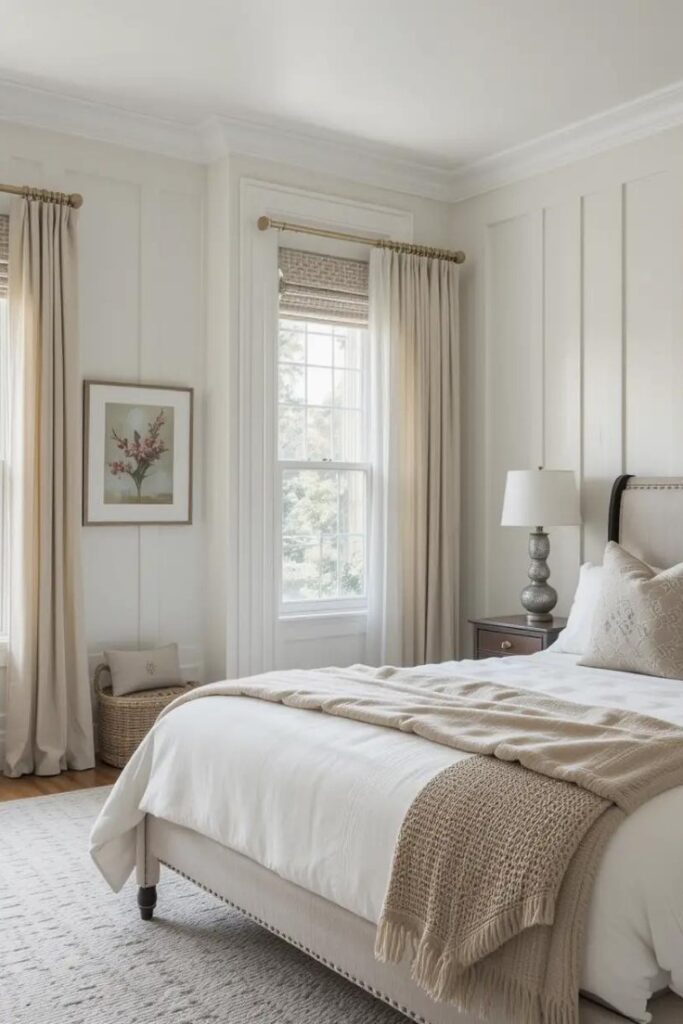
If your bedroom lacks architectural interest, consider adding simple design elements to enhance your neutral space. Crown molding, wainscoting, shiplap, or a simple board and batten wall treatment can add significant character to a neutral bedroom without disrupting its calm aesthetic.
In rooms with existing architectural features, painting them the same color as walls (or a slightly lighter or darker shade) highlights these details while maintaining the neutral bedroom’s cohesive look.
5. Use Monochromatic Neutrals
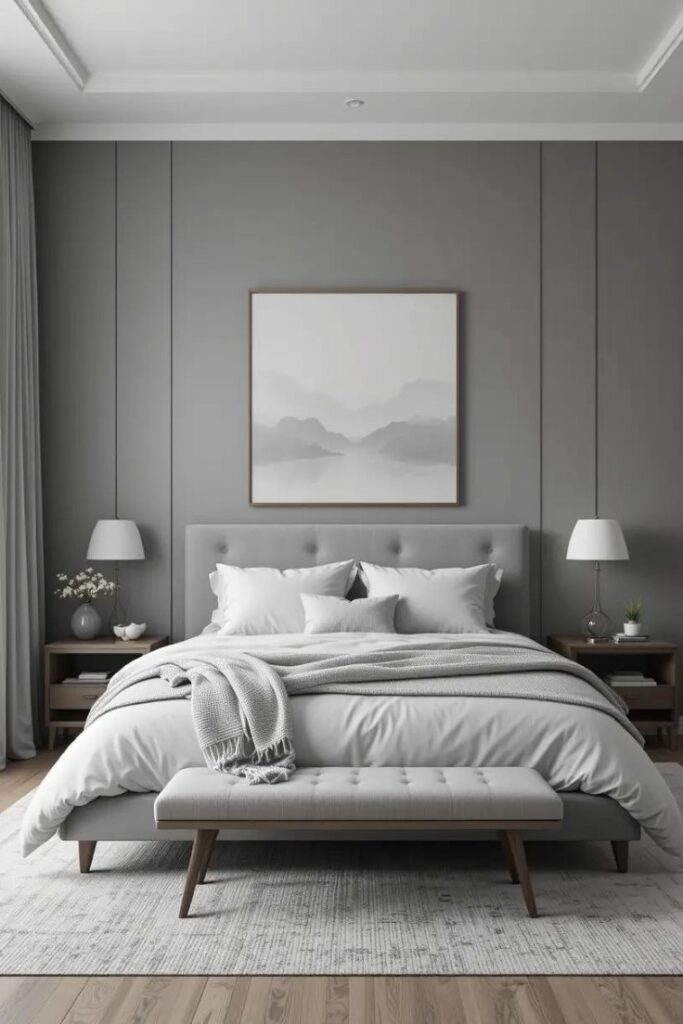
A monochromatic approach uses varying shades of a single neutral color to create a sophisticated, cohesive neutral bedroom. Working within one color family—like different intensities of warm beige or cool gray—creates a harmonious space that feels intentional rather than bland.
For example, in a gray neutral bedroom, incorporate charcoal, medium gray, and light gray elements. The subtle variations create depth while maintaining a clean, uncluttered visual effect.
6. Add Subtle Pattern to Your Neutral Bedroom
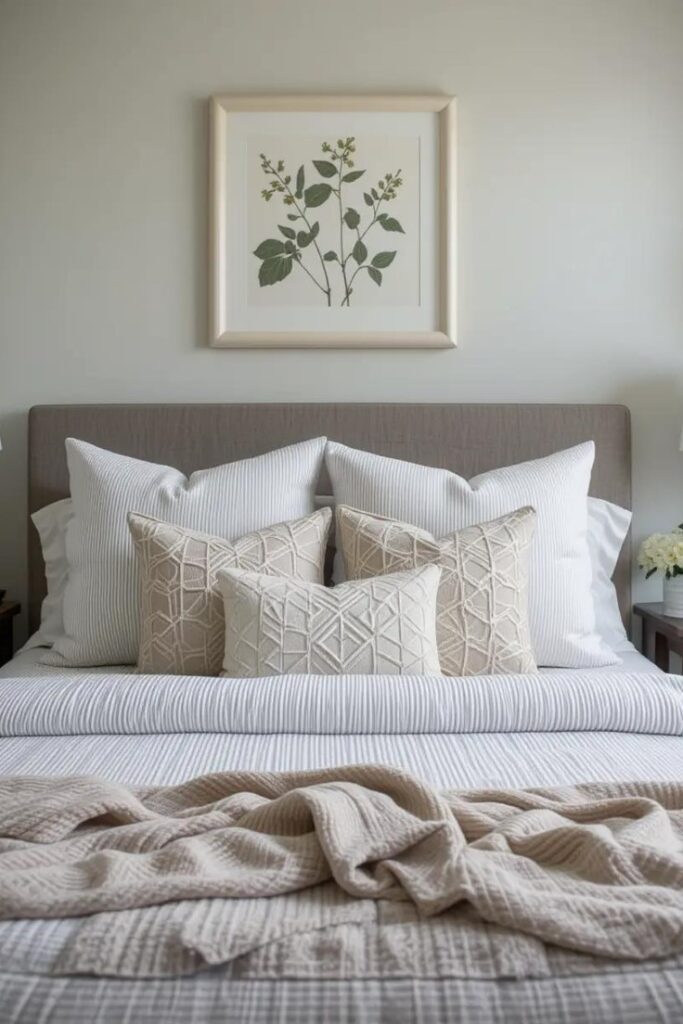
Patterns add interest to a neutral bedroom without compromising its calming quality when used strategically. Incorporate subtle patterns through bedding, pillows, rugs, or window treatments to enhance your neutral bedroom while maintaining its serene atmosphere.
Effective pattern options for neutral bedrooms include:
- Tone-on-tone stripes
- Gentle geometric designs
- Subtle botanical prints
- Small-scale patterns in neutral tones
- Textured weaves that create visual pattern
The key is choosing patterns that complement rather than compete with the room’s peaceful quality.
7. Balance Warm and Cool Neutrals
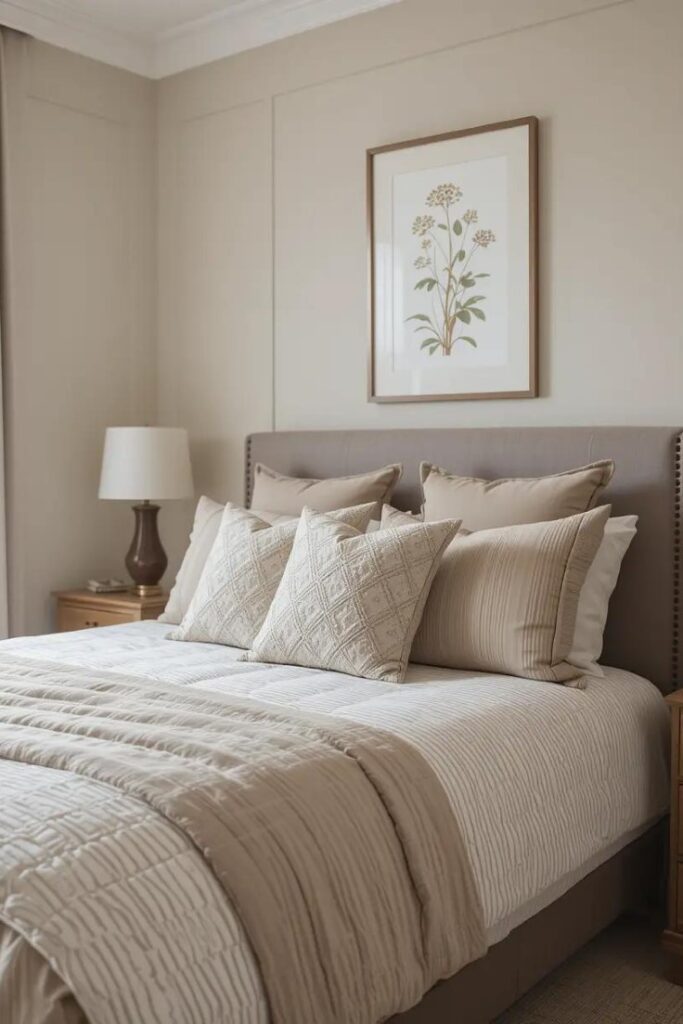
Creating balance between warm and cool neutral tones helps a bedroom feel complete and harmonious. If your neutral bedroom feels too sterile, introducing warm elements like honey-toned wood or cream textiles can add necessary warmth; conversely, cool gray or white accents can prevent a warm neutral bedroom from feeling too heavy.
This balancing act often happens naturally when incorporating various materials.
8. Create a Neutral Bedroom with Strategic Contrast
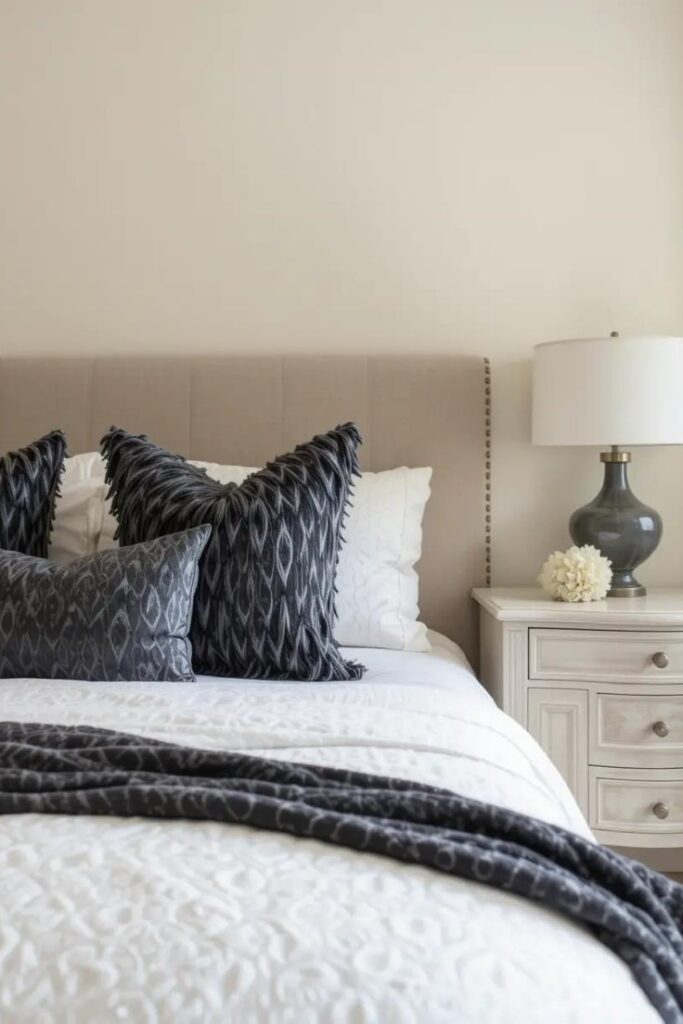
Even within a neutral palette, strategic contrast helps define spaces and prevent monotony. Consider incorporating small elements of contrast in your neutral bedroom through darker accent pieces against lighter backgrounds, or by including metals that stand out against soft textiles.
Some effective contrast elements for a neutral bedroom include:
- Black picture frames against light walls
- Dark wooden furniture legs against a light carpet
- Brushed brass hardware on pale cabinetry
- Charcoal throw pillows on cream bedding
These thoughtful contrasts provide visual anchors that help the eye navigate the subtlety of a neutral bedroom.
For curtain ideas, check out 18 Elegant Bedroom Curtain Ideas for a Polished Look.
9. Use Soft Lighting in Your Neutral Bedroom
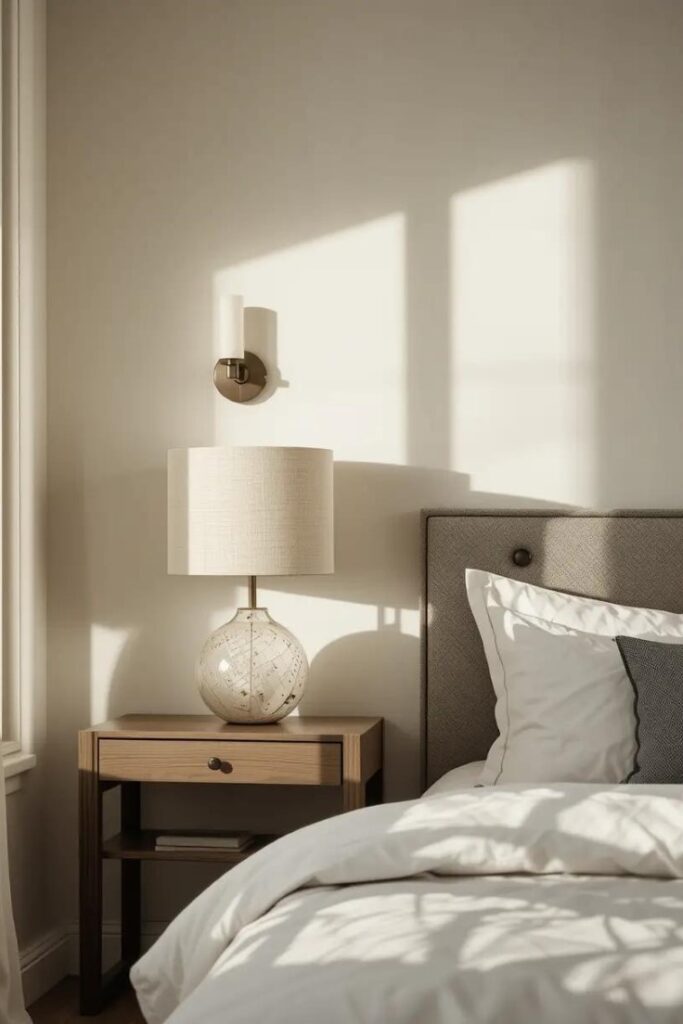
Lighting dramatically affects how neutrals appear and feel in a bedroom. Soft, warm lighting enhances the cozy quality of a neutral bedroom, making it feel inviting rather than stark or cold.
Consider these lighting options:
- Table lamps with linen or fabric shades
- Wall sconces with adjustable brightness
- String lights for gentle ambient lighting
- Candles for natural, flickering light
- Smart bulbs that can be adjusted to warmer tones
Avoid harsh overhead lighting in favor of multiple, softer light sources positioned strategically throughout your bedroom.
10. Incorporate Minimal Black Accents
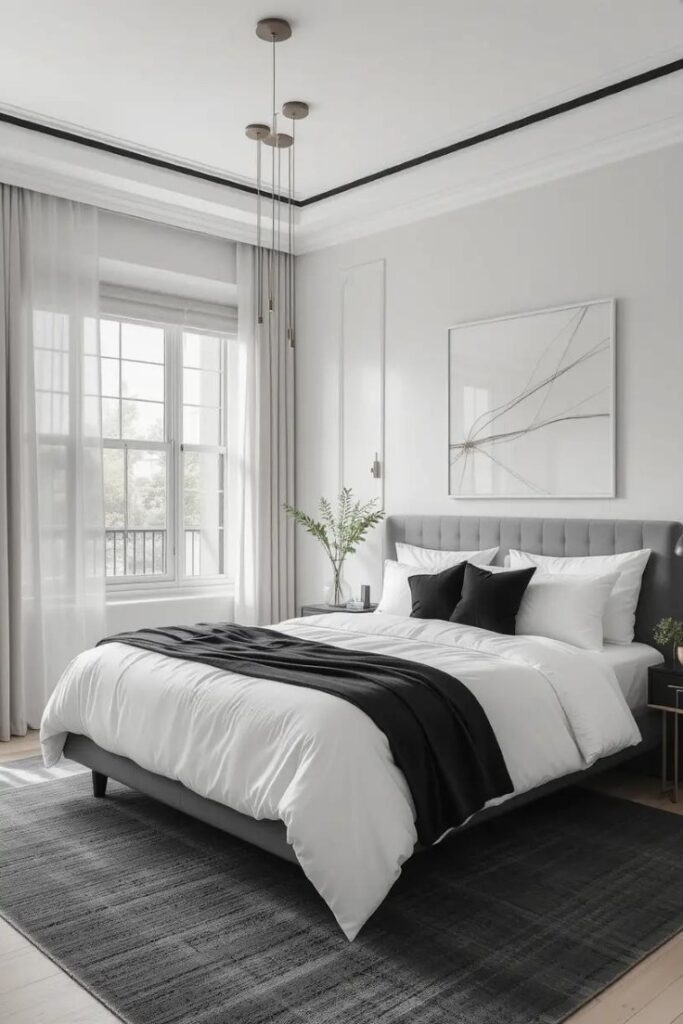
Small black elements can anchor a neutral bedroom and prevent it from feeling too delicate or undefined. Used sparingly, black details like lamp bases, picture frames, or hardware add sophistication and definition to a neutral bedroom without compromising its light, airy quality.
The key is balance—too many dark elements will overpower a neutral bedroom, while just enough provides necessary grounding and visual interest.
11. Design a Minimalist Neutral Bedroom
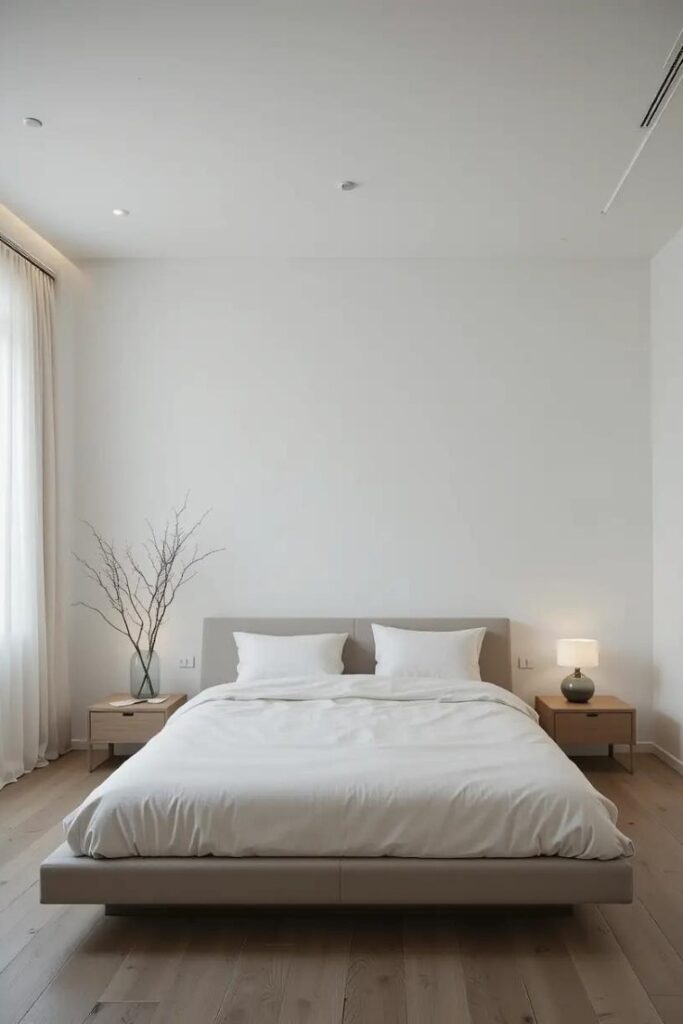
Neutral color schemes naturally complement minimalist design approaches. A minimalist neutral bedroom focuses on quality over quantity, featuring carefully selected furnishings and minimal decoration to create a profoundly restful space.
In this approach:
- Choose multi-functional furniture pieces
- Keep surfaces clear of unnecessary items
- Select high-quality bedding in simple designs
- Eliminate visual clutter and excess décor
- Prioritize pieces with clean lines and simple forms
This combination of neutral colors and minimalist design principles creates an exceptionally calming bedroom environment.
12. Create a Neutral Bedroom with Subtle Color Accents
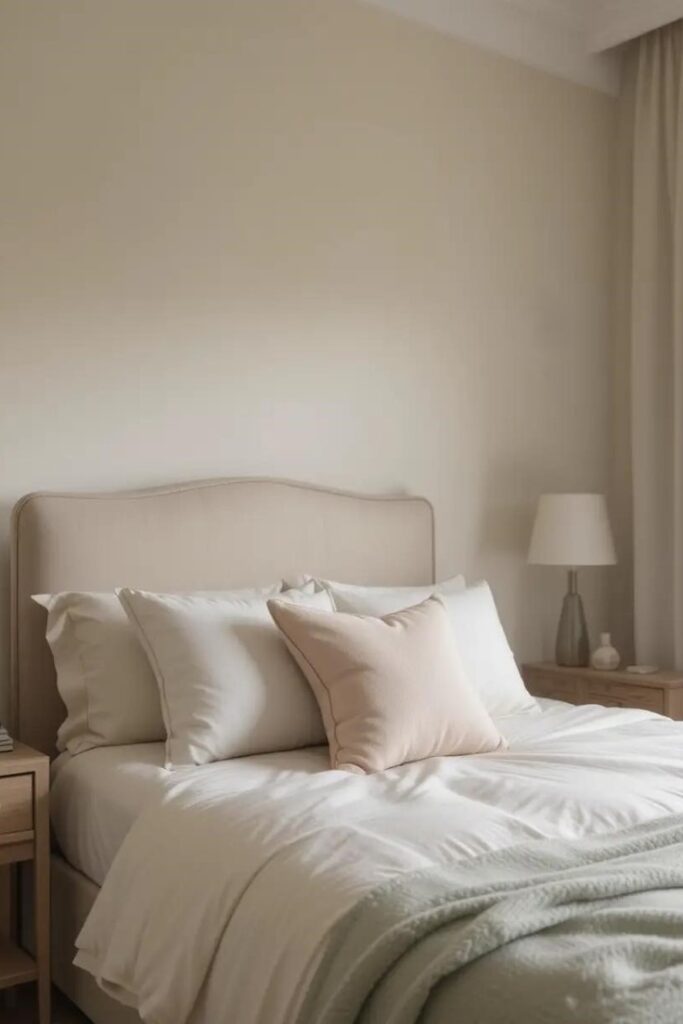
While maintaining a primarily neutral bedroom, subtle color accents can add personality without disrupting the room’s peaceful quality. Consider incorporating muted, dusty versions of colors like sage green, blush pink, or pale blue as gentle accents in an otherwise neutral bedroom.
These soft color additions might appear as:
- A single decorative pillow
- A throw blanket at the foot of the bed
- A small collection of colored glassware
- Dried botanical elements
- Abstract artwork incorporating subtle color
The goal is introducing color that complements rather than competes with your bedroom palette.
13. Focus on Quality Bedding
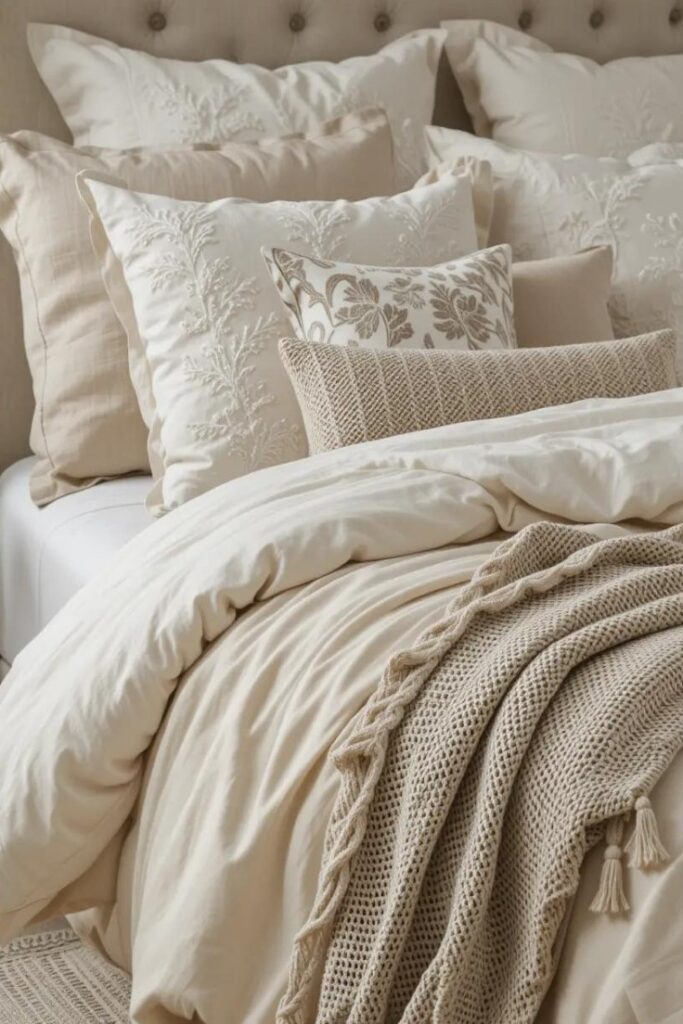
In a neutral bedroom, the bed naturally becomes a focal point, making quality bedding essential. Invest in the best bedding you can afford, focusing on natural materials like cotton, linen, or bamboo that enhance comfort while contributing to your neutral bedroom’s aesthetic appeal.
Layer different textures and slightly varied neutral tones to create a bed that looks inviting and feels luxurious. Consider:
- A simple duvet in a core neutral shade
- Various pillow sizes in complementary tones
- A textured throw blanket for added dimension
- Quality sheets with subtle details like hemstitching
These layers create a bed that serves as both the functional and visual center of your neutral bedroom.
14. Add Interest with Metallic Elements
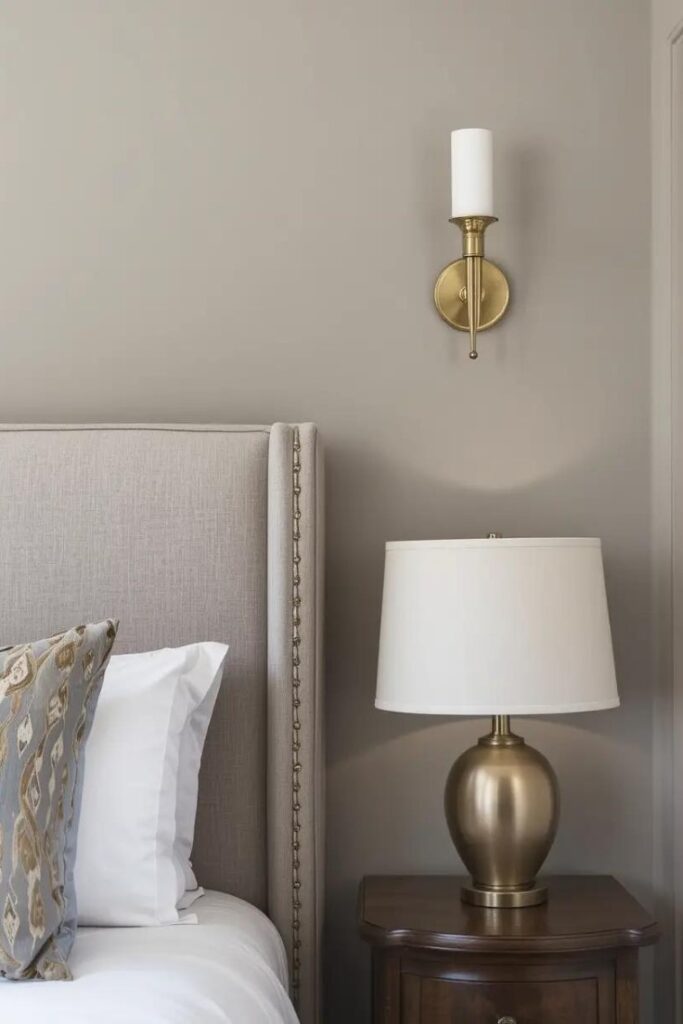
Metallic accents add subtle shimmer and reflection that enhances a neutral bedroom without adding color. Incorporate metals like brass or copper through lighting fixtures, furniture details, or decorative objects to add sophistication and visual interest to your neutral space.
Different metals create different effects:
- Brass add warmth to cool neutral bedrooms
- Silver and chrome add modern crispness to warm neutral palettes
- Mixed metals create an eclectic, collected look
- Brushed or antiqued finishes offer subtlety compared to high-polish options
Used thoughtfully, these metallic elements catch light and add dimension to a neutral bedroom.
15. Create a Serene Neutral Bedroom with Plants
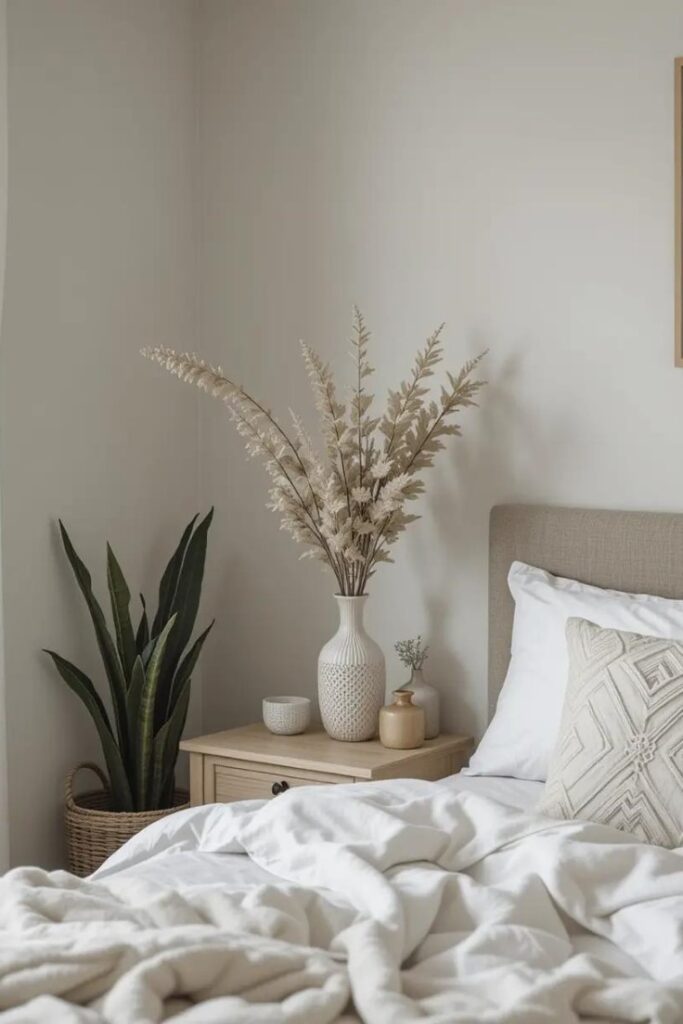
Living plants bring natural energy and subtle color to a neutral bedroom while improving air quality. Choose plants with interesting forms and textures that complement your neutral palette—snake plants, fiddle leaf figs, olive trees, and pothos all offer distinctive silhouettes without overwhelming color.
If your neutral bedroom has limited natural light or you prefer low-maintenance options, consider:
- Dried pampas grass or preserved eucalyptus
- High-quality faux plants in natural forms
- Air plants requiring minimal care
- Branches displayed in simple vases
These natural elements add life and subtle movement to a neutral bedroom.
Creating Your Perfect Neutral Bedroom
The most successful neutral bedrooms balance simplicity with thoughtful detail. By carefully considering texture, subtle variation, quality materials, and strategic accents, you can create a neutral bedroom that feels richly layered rather than plain or boring.
Remember that “neutral” encompasses a wide range of possibilities—from warm honey tones to cool grays, from creamy whites to sophisticated taupes. Finding your perfect neutral palette might take some experimentation, but the resulting peaceful bedroom will be worth the effort.
Whether you prefer a minimalist approach or a more layered neutral bedroom with various textures and materials, these ideas provide a foundation for creating a space that promotes rest, relaxation, and renewal.
FAQ About Neutral Bedrooms
What are the best neutral colors for a small bedroom?
Lighter neutrals like soft white, pale gray, and gentle beige can help a small neutral bedroom feel larger and more open. Consider using the same color on walls, trim, and ceiling to create a seamless look that expands the space visually. Add depth through textural elements rather than contrasting colors.
How can I prevent my neutral bedroom from looking boring?
The key to an interesting neutral bedroom is incorporating varied textures, subtle pattern, and thoughtful contrast. Layer different materials like linen, cotton, wool, and wood; include subtle patterns in textiles; and add small contrasting elements like black picture frames or metallic accents to create visual interest without compromising the room’s peaceful quality.
What’s the best way to add color to a neutral bedroom?
Introduce color through easily changeable elements like throw pillows, blankets, small decorative objects, or botanical elements. Choose muted, dusty versions of colors that complement your neutral palette—sage green, blush pink, dusty blue, or terracotta all work well. Keep colored elements minimal and strategic to maintain the essentially neutral character of the room.
Which metals work best in a neutral bedroom?
The best metals for your neutral bedroom depend on the undertones in your neutral palette. Warm neutrals like beige, cream, and taupe typically pair beautifully with brass, gold, or copper. Cooler neutrals like gray and crisp white often complement silver, chrome, or blackened metals. Don’t be afraid to mix metals thoughtfully for an evolved, collected look.
How do I choose the right white for a neutral bedroom?
Consider the room’s natural light and other elements when selecting white paint. North-facing rooms benefit from warmer whites to counterbalance cool light, while south-facing rooms can handle cooler whites. Look at the undertones—creamy whites have yellow undertones, while crisp whites have blue undertones. Always test paint samples on your actual walls before committing, as whites appear dramatically different depending on lighting conditions.
Can I use dark colors in a neutral bedroom?
Yes, darker neutrals like charcoal gray, deep taupe, or even soft black can create a sophisticated, cocooning neutral bedroom. When using darker neutrals, balance them with lighter elements through bedding, rugs, or furniture to prevent the space from feeling too heavy. Ensure adequate lighting, particularly if the room has limited natural light.

